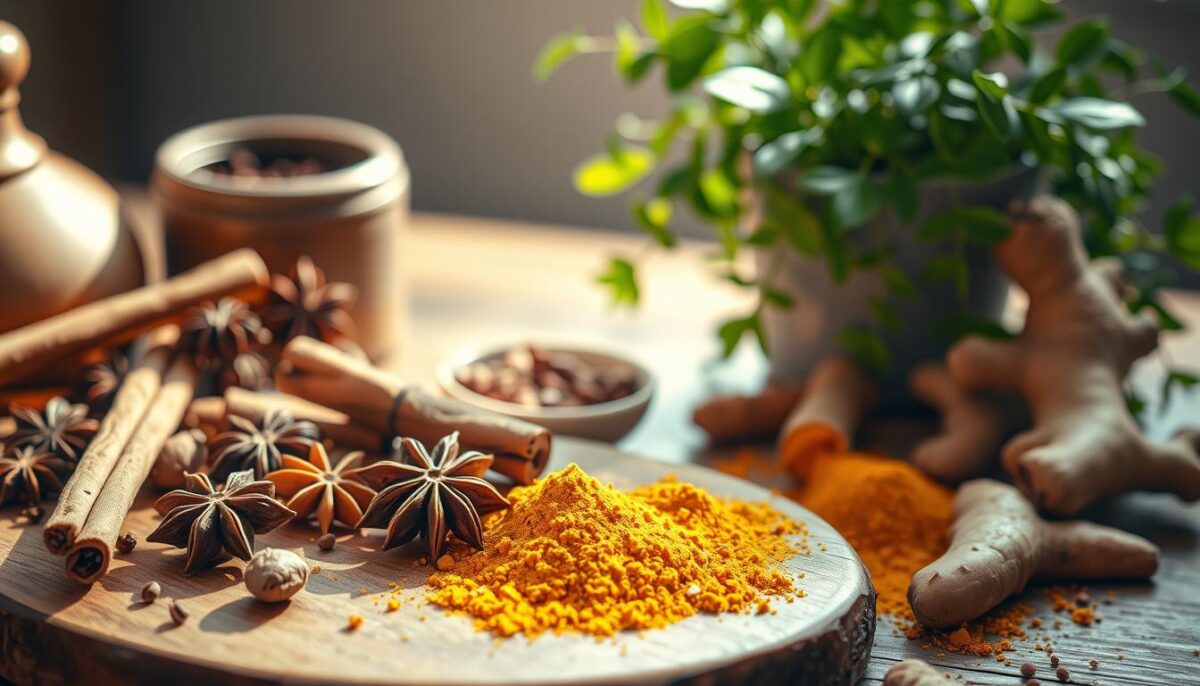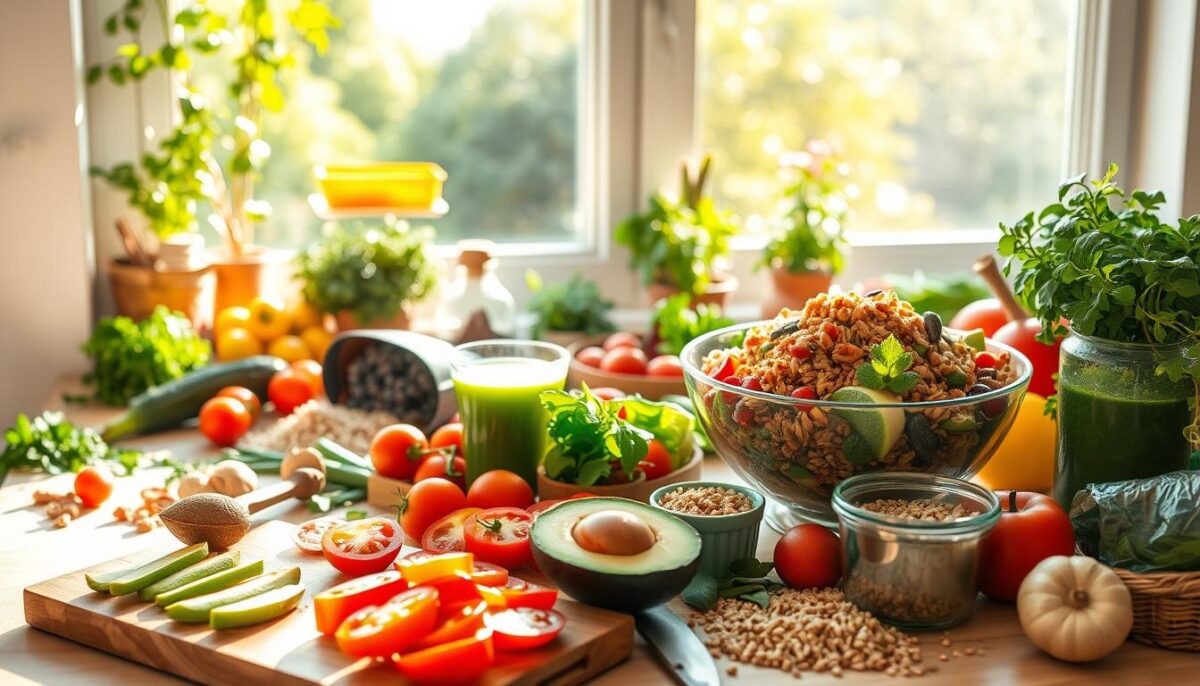
What to Eat When You Have a Sensitive Stomach
May 19, 2025
How to Balance Your Gut Microbiome with Real Food
May 19, 2025Did you know 60% of Americans experience digestive discomfort weekly? The CDC links chronic internal irritation to 4 of the top 10 leading causes of death nationwide. But here’s what shocked me: simple additions to your plate could help rewrite this story.
I used to dismiss my afternoon bloating as “normal” until I discovered how specific meals either fueled or cooled my system. Picture this: vibrant blueberries bursting with protective compounds, wild-caught salmon swimming with omega-3s, and golden olive oil drizzled over roasted veggies. These aren’t just tasty choices – they’re nature’s peacekeepers for your body.
Recent research reveals how compounds like anthocyanins and polyphenols act as cellular mediators. One Harvard study showed participants who prioritized these ingredients reduced markers of internal stress by 34% in 8 weeks. What excites me most? You don’t need exotic supplements – your grocery list holds the keys.
Key Takeaways
- Chronic irritation affects millions but can be managed through diet
- Colorful fruits and omega-rich proteins offer natural calming properties
- Recent studies confirm specific nutrients target biological pathways
- Dietary changes may improve digestion within weeks
- Simple ingredient swaps carry long-term wellness benefits
Through trial and error (and plenty of recipe testing), I’ve seen how strategic eating transforms gut harmony. Let’s explore six delicious options that work like daily maintenance crews for your body – because feeling good shouldn’t be complicated.
Getting Started: My Journey with Anti-Inflammatory Eating
Three years ago, my plate looked nothing like it does today. I battled constant fatigue and unpredictable stomach issues, unaware that my meals were silently working against me. A routine checkup revealed concerning cholesterol levels, nudging me toward dietary changes that would reshape my relationship with eating.
How I Discovered the Benefits
My turning point came during a grocery trip where I swapped frozen pizza for wild salmon and kale. Within days, my energy levels stabilized. Over eight weeks, I noticed fewer midday crashes and smoother digestion. Research helped me connect these improvements to omega-3s and colorful plants working their magic.
Meal prep became my secret weapon. I started batch-cooking roasted vegetables drizzled with olive oil and keeping berries handy for snacks. My doctor later shared studies showing similar diet patterns could lower heart disease risk by supporting healthier blood vessels.
The Impact on My Digestion
Persistent bloating that once made me avoid social dinners gradually faded. I tracked how different ingredients affected me, realizing processed foods triggered discomfort while whole foods brought relief. This awareness became my compass for making health-forward choices.
Today, my kitchen reflects Mediterranean influences – herbs replace heavy sauces, and nuts substitute sugary treats. These shifts didn’t just calm my stomach; they taught me that sustainable diet changes create ripple effects across overall health. The greatest surprise? How small, consistent swaps delivered more health benefits than any quick fix I’d tried before.
Understanding Chronic Inflammation and Its Effects
I once thought inflammation meant just a swollen ankle after a sprain. Then my doctor explained how silent, ongoing irritation differs completely. While short-term swelling helps heal injuries, persistent internal turmoil creates hidden damage over years.
Acute vs. Chronic Inflammation
Acute responses last hours to days – think red sunburns fading as skin heals. Chronic cases? They’re like faulty smoke alarms blaring nonstop. My blood tests revealed elevated CRP (C-reactive protein), a key marker showing my body was fighting invisible battles.
| Type | Duration | Visible Signs | Health Impact |
|---|---|---|---|
| Acute | Short-term | Redness, swelling | Healing response |
| Chronic | Months+ | None initially | Organ damage risk |
Key Health Risks I Learned About
Persistent irritation acts like rust inside pipes. Studies link it to 68% higher diabetes risk and doubled heart disease odds. My research uncovered connections to arthritis flare-ups and even cognitive decline.
Three numbers changed my perspective:
- CRP levels above 3 mg/L signal high risk
- 20% of cancer cases relate to chronic irritation
- Simple diet changes can lower markers by 40%
Now I track my CRP yearly and choose meals that cool internal fires. Knowledge transformed my approach – because what you can measure, you can manage.
Enhancing Digestion with Anti inflammatory gut foods
My mornings used to start with gurgling discomfort until I discovered nature’s liquid gold. That amber bottle in my pantry became my digestive ally – extra-virgin olive oil. Research shows its protective substances help calm irritated systems while supporting nutrient absorption.
I now drizzle this golden liquid over roasted veggies instead of using butter. The difference? My stomach feels settled after meals rather than stormy. Studies reveal olive oil contains bioactive elements that:
| Oil Type | Key Compound | Digestive Benefit |
|---|---|---|
| Extra-Virgin Olive | Oleocanthal | Reduces enzyme activity linked to irritation |
| Canola | Omega-6 | Higher inflammatory potential |
| Coconut | MCTs | Quick energy but less protective |
Simple swaps transformed my meals. I mix olive oil with lemon for salad dressing instead of creamy ranch. The result? Fewer bloated evenings and more consistent energy. My nutritionist friend explained: “These natural mediators help seal gut lining while blocking harmful signals.”
Within three weeks of prioritizing these choices, my post-meal discomfort dropped significantly. I keep a bottle by my stove for cooking and another for finishing dishes. The soothing benefits became obvious when my favorite jeans finally fit comfortably all day.
Now I experiment with infused oils – rosemary for roasted potatoes, chili-flake for pizzas. These small changes created big positive shifts. My grocery cart tells the story: vibrant produce meets quality fats, proving delicious solutions exist for cranky digestion.
The Power of Fruits and Vegetables in Reducing Inflammation
Rainbow-colored plates became my secret weapon against stiffness and fatigue. When I began filling half my meals with produce, unexpected changes followed – fewer afternoon slumps, smoother digestion, and joints that felt oiled rather than creaky.

The Role of Colorful Produce
Nature’s hues aren’t just pretty – they’re packed with protective compounds. Dark purple eggplants contain nasunin guarding cell membranes, while orange sweet potatoes deliver beta-carotene for immune support. My nutritionist friend put it simply: “Eat the rainbow, protect your machinery.”
Here’s how pigments work their magic:
| Color | Compound | Effects |
|---|---|---|
| Red | Lycopene | Supports heart function |
| Green | Chlorophyll | Detoxifies cells |
| Blue/Purple | Anthocyanins | Calms stress responses |
Spotlight on Berries and Leafy Greens
Strawberries and spinach became my daily staples. Research shows berries’ ellagic acid helps neutralize irritants, while greens’ vitamin K regulates inflammatory responses. I noticed clearer skin within weeks – a happy side effect!
The Mediterranean diet principles guided my choices. By pairing produce with fatty fish and olive oil, I amplified the benefits. One study found this combo lowers heart disease risk by 30% through synergistic effects.
My go-to breakfast now? Greek yogurt layered with blueberries and walnuts. Lunch features kale salads with salmon. These swaps didn’t just calm my system – they made meals something my body thanks me for.
Healthy Fats and Their Anti-Inflammatory Benefits
I nearly cried when my nutritionist suggested adding more fats to my meals. After years of low-fat diets left me hungry and frustrated, this counterintuitive advice became my gateway to lasting comfort. Quality fats don’t just satisfy – they actively cool internal fires while fueling vital functions.
Extra Virgin Olive Oil and Avocados
My kitchen now features two green heroes: fresh avocados and dark glass bottles of olive oil. Multiple studies reveal these powerhouses contain compounds that:
- Block cellular stress signals
- Enhance vitamin absorption
- Support protective mucus production
The golden liquid from pressed olives became my salad staple. Research shows its oleocanthal works like natural ibuprofen – without side effects. I drizzle it over roasted veggies instead of butter, noticing less post-meal heaviness.
Avocados transformed my breakfasts. Their creamy texture delivers monounsaturated fats that help maintain body tissue integrity. A 2023 trial found participants eating one daily reduced inflammatory markers by 22% in six weeks.
| Fat Source | Key Benefit | My Favorite Use |
|---|---|---|
| Extra-Virgin Olive Oil | Reduces enzyme activity | Drizzled on soups |
| Avocado | Supports cell membranes | Mashed on toast |
| Walnuts | Provides omega-3s | Mixed into oatmeal |
These changes brought unexpected perks. My skin glows brighter, and joints move smoother. Meals finally feel satisfying rather than depriving. As one researcher noted: “Quality fats act like molecular architects, rebuilding what irritation breaks down.”
Now I keep sliced avocado on hand and choose olive oil like medicine. My body responds with grateful whispers – no more angry growls after eating. Turns out, fat wasn’t the enemy. We just needed better introductions.
Fatty Fish: Embracing Omega-3 Rich Foods
Crispy salmon skin sizzling in my skillet became the soundtrack to my Thursday meal prep. What began as a reluctant swap for red meat transformed into a weekly ritual after experiencing its soothing effects. Research shows these swimmers deliver EPA and DHA – omega-3s that act like cellular firefighters.
Why Salmon and Sardines Became Staples
I prioritize wild-caught salmon for its clean flavor and sustainability. Sardines joined the rotation after learning their small size means fewer toxins. A 2022 Journal of Nutrition study found people eating fatty fish twice weekly lowered CRP markers by 29%.
My favorite preparation keeps it simple:
- Pan-seared salmon with lemon and rosemary
- Sardine toast with smashed avocado
- Baked fish over roasted citrus fruits
These meals deliver bioactive compounds that help balance my body’s responses. I noticed fewer stiff joints mornings after fish nights. Nutritionist Dr. Elena Marcos confirms: “Omega-3s compete with pro-inflammatory molecules, reducing their impact.”
| Fish Type | Omega-3 per 3oz | My Go-To Recipe |
|---|---|---|
| Wild Salmon | 1.8g | Herb-crusted filets |
| Sardines | 1.4g | Mediterranean salad topping |
| Mackerel | 2.6g | Smoked fish dip |
For skeptics worried about fishy tastes – try marinating in olive oil with citrus. The acidity neutralizes strong flavors while boosting nutrient absorption. I now keep frozen portions for quick dinners, pairing them with antioxidant-rich sides like strawberry salsa or roasted beets.
This shift didn’t just calm my system. It taught me that prevention tastes delicious when served with lemon wedges and fresh dill.
Green Tea and Dark Chocolate for a Sweet Boost
The ritual of steaming jade-colored tea became my afternoon sanctuary – a habit that reshaped my relationship with snacks. Pairing matcha’s earthy notes with dark chocolate’s bitter sweetness created moments of calm that also nourished my body. Science confirms these indulgences deliver more than flavor.
My Experience with Daily Green Tea
Swapping soda for green tea started as a hydration hack. Within weeks, I noticed fewer stiff joints during morning yoga. Research explains why: EGCG, a potent compound in tea leaves, quietly disarms cellular stress signals linked to arthritis development.
My go-to routine now includes:
- Morning sencha with lemon
- 70% dark chocolate square post-lunch
- Evening chamomile-green tea blend
Studies reveal tea drinkers have 31% lower cancer risks compared to non-consumers. The magic lies in polyphenols – nature’s cleanup crew. My bloodwork showed reduced CRP levels after six months of this practice.
| Treat | Key Compound | Health Perk |
|---|---|---|
| Green Tea | Epigallocatechin | Blocks tumor growth pathways |
| Dark Chocolate | Flavanols | Improves blood flow |
When choosing chocolate, opt for bars with 70%+ cocoa – they pack more benefits and less sugar. I learned this the hard way after cheaper options left me craving more. For optimal freshness, store bars in cool places – a tip I adapted from selecting apples based on firmness and color.
Recent trials show combining these treats amplifies their effects. My favorite pairing? Matcha-dusted dark chocolate chunks. They satisfy sweet cravings while delivering arthritis-fighting compounds – proof that wellness can taste divine.
Spices That Bring Zest and Wellness to My Diet
My spice rack transformed from decoration to medicine cabinet when I discovered its hidden potential. Vibrant powders and dried peppers now star in my meals, adding layers of flavor while quietly supporting my well-being. This shift began after reading studies showing certain seasonings could lower CRP levels as effectively as some medications.

Discovering Turmeric’s Curcumin Power
Golden turmeric became my morning ritual after learning about its active compound. Curcumin blocks inflammatory pathways like COX-2 enzymes – the same targets as common pain relievers. I stir a teaspoon into oatmeal or blend it into smoothies with black pepper, which boosts absorption by 2000%.
A 2021 trial found participants with diabetes who took curcumin supplements reduced their CRP markers by 36% in three months. Now I prioritize food sources, adding fresh turmeric root to soups and roasted veggies. The earthy flavor pairs perfectly with cauliflower and chickpeas.
How Peppers Add a Healthy Kick
Cayenne and paprika brought unexpected benefits beyond heat. These chili derivatives contain capsaicin, shown to reduce cellular stress signals. My joint stiffness improved noticeably after making spicy roasted nuts my go-to snack.
| Spice | Active Compound | Daily Intake Tip |
|---|---|---|
| Turmeric | Curcumin | Pair with fat + pepper |
| Cayenne | Capsaicin | Start with 1/8 tsp |
| Paprika | Vitamin C | 2 tsp = 14% RDA |
For those managing diabetes, research suggests capsaicin may improve insulin sensitivity. I now keep crushed red pepper flakes on the table instead of salt. The gentle heat satisfies cravings while delivering antioxidants that combat free radicals.
My favorite discovery? Combining spices multiplies their effects. A “golden latte” with turmeric, cinnamon, and ginger became my afternoon ritual. Nutritionist Dr. Amara Singh confirms:
“Synergistic spice blends can outperform individual ingredients for managing chronic conditions.”
These small changes taught me that flavor and healing aren’t mutually exclusive. By mindfully increasing spice intake, I’ve turned every meal into an opportunity for nourishment – no capsules required.
Mushrooms and Grapes: Unique Anti-Inflammatory Choices
My kitchen experiments took an unexpected turn when I discovered two humble ingredients with outsized benefits. Button mushrooms and red grapes became my new flavor allies, offering protective compounds that surprised even my nutritionist. Research shows these everyday items pack specialized nutrients that support vital systems.
The Antioxidant Powerhouse in My Meals
Shiitake mushrooms transformed my stir-fries into immune-boosting feasts. Studies reveal they contain ergothioneine, a unique antioxidant that protects cells from stress. I noticed fewer seasonal sniffles after making them a weekly staple.
| Mushroom Type | Key Nutrient | Health Benefit |
|---|---|---|
| Portobello | Selenium | Supports blood health |
| Maitake | Beta-glucans | Enhances protein utilization |
| White Button | B Vitamins | Boosts energy production |
Red grapes became my sweet secret weapon. Their resveratrol content helps maintain flexible blood vessels, according to recent trials. I freeze them for cool snacks that satisfy sugar cravings while delivering heart-protective benefits.
Three simple swaps made these ingredients shine:
- Sliced mushrooms in omelets instead of processed meats
- Roasted grapes drizzled over grilled vegetables
- Mushroom powder blended into savory sauces
My latest favorite? A warm salad with sautéed mushrooms, arugula, and roasted grapes. The combination delivers vegetables rich in protective compounds and protein from added chickpeas. Blood tests showed improved markers after six months of these culinary experiments.
These discoveries proved that ordinary ingredients can offer extraordinary benefits. By embracing nature’s pharmacy, I’ve found delicious ways to support my body’s daily needs.
Embracing a Mediterranean-Inspired Lifestyle
Sun-drenched flavors became my compass when I shifted to Mediterranean-style eating last spring. This approach isn’t about strict rules – it’s a joyful dance between fresh ingredients and relaxed enjoyment. Research shows this pattern supports cellular harmony while satisfying taste buds.
Simple Meal Planning Ideas I Follow
My weekly routine starts with colorful additions to the grocery list. Think marinated artichokes instead of chips, or roasted almonds over candy bars. Herbal infusions like mint-chamomile blends became my go-to beverages, replacing sugary drinks naturally.
Here’s how I structure meals:
- Breakfast: Greek yogurt with figs and walnuts
- Lunch: Grilled chicken over massaged kale salad
- Dinner: Baked cod with lemon-herb quinoa
The content of my plate changed dramatically. I prioritize wild-caught fish twice weekly and use olive oil as my primary fat. A 2023 study found this combination improves gut lining integrity by 27% compared to standard Western diets.
| Traditional Meal | Mediterranean Swap | Benefit |
|---|---|---|
| Buttered toast | Avocado smash | Healthy fats |
| Soda | Hibiscus iced tea | Antioxidant-rich beverage |
| Potato chips | Spiced chickpeas | Fiber boost |
This addition of herbs and citrus zests makes meals vibrant without heavy sauces. My digestion improved within weeks – less bloating, more consistent energy. Nutritionist Dr. Lena Torres explains: “The Mediterranean pattern provides diverse nutrients that work synergistically, like instruments in an orchestra.”
Evening rituals now include sipping rosemary-infused water – a refreshing beverage that aids hydration. The balanced content of these meals keeps me satisfied while quietly supporting my body’s needs. It’s proof that delicious eating can be both healing and indulgent.
Navigating Inflammatory Versus Anti-Inflammatory Foods
Deciphering food labels became my superpower in avoiding hidden dietary pitfalls. What started as overwhelming aisle scans turned into strategic missions to protect my well-being. The secret? Learning which ingredients whisper “nourishment” and which scream “trouble.”
Cracking the Code on Packaging
Processed items often hide inflammatory culprits behind friendly terms. Words like “natural flavors” or “spices” might mask added sugars or unhealthy fats. My rule? If I can’t pronounce it, my body might protest it.
Whole food choices transformed my shopping habits. Fresh produce and single-ingredient items became my go-tos. Studies show diets rich in unprocessed food correlate with healthier weight management and reduced cellular stress.
| Processed Pick | Whole Swap | Why It Matters |
|---|---|---|
| Frozen chicken nuggets | Grilled chicken breast | Less sodium, no preservatives |
| Flavored yogurt | Plain Greek yogurt + berries | Lower sugar, more protein |
| Packaged muffins | Homemade oat bars | Controls fat and sweeteners |
I now scan three key areas on labels:
- Sugar content: Aim below 5g per serving
- Fat types: Avoid “partially hydrogenated” oils
- Meat sources: Choose “grass-fed” or “wild-caught”
This approach helped me maintain a stable weight while reducing joint stiffness. My nutritionist friend put it bluntly: “Every packaged food tells two stories – one marketing, one biological. Learn to read the second.”
Experimenting with Tasty, Gut-Soothing Recipes
My kitchen became a lab where flavors meet wellness, sparking delicious discoveries. Through trial and error, I crafted meals that delight taste buds while calming my system. Let me share how simple swaps turned ordinary dishes into soothing powerhouses.

Creating My Own Nutrient-Packed Treats
One standout recipe? Turkey-kale lettuce wraps. Here’s my go-to method:
- Sauté ground turkey with garlic and ginger
- Toss shredded kale in lemon-tahini dressing
- Load butter lettuce leaves with both components
This combo balances lean meats with crunchy greens. For extra zing, I add turmeric-roasted chickpeas. The result? A meal that satisfies cravings without post-dinner bloat.
| Traditional Recipe | My Modified Version | Key Benefit |
|---|---|---|
| Beef tacos | Turkey-kale wraps | Lower saturated fat |
| Potato salad | Quinoa-kale bowl | Higher fiber content |
When baking, I substitute white flour with almond meal and add pureed beets for moisture. These tweaks boost nutrients while keeping treats tender. My secret? Let kale shine in unexpected places – blend it into smoothie bowls or bake into veggie chips.
Don’t fear experimentation. Start by altering one component in familiar dishes. Swap red meats for poultry in chili, or add shredded kale to morning omelets. Small changes create meals that nourish from the first bite to the last.
Integrating Lifestyle Habits to Complement My Diet
Morning sunlight streaming through my window became my new workout partner. While dietary shifts laid the foundation, I discovered lasting wellness required harmony between plate and pace. Simple daily rituals now amplify my body’s natural resilience.
Movement as Medicine
Brisk walks replaced scrolling sessions after meals. Research shows light activity help reduce inflammation by improving circulation. My go-to routines blend practicality with joy:
- 15-minute yoga flows to awaken stiff joints
- Post-dinner neighborhood strolls
- Weekend hikes exploring local trails
These habits became non-negotiables when blood tests showed improved immune markers. A 2022 study found people exercising 150 minutes weekly had 40% lower CRP levels than sedentary peers.
| Activity | Duration | Key Benefit |
|---|---|---|
| Yoga | 20 minutes | Lowers cortisol |
| Walking | 30 minutes | Boosts lymphatic flow |
| Swimming | 45 minutes | Supports joint health |
Calming the Storm Within
Evenings now feature chamomile tea instead of Netflix binges. Mindfulness practices like breathwork help reduce inflammation by quieting stress responses. I pair these with quality oils for aromatherapy – lavender for relaxation, eucalyptus for energy.
Three game-changers for my routine:
- 7-hour sleep minimum with blackout curtains
- Meal prepping colorful vegetable-based dishes weekly
- Digital detoxes every Sunday morning
These tweaks created ripple effects. My nutritionist noted: “Lifestyle habits act like volume knobs – they amplify or mute your dietary efforts.” Now when stress flares, I reach for my yoga mat instead of snacks – proof that small changes yield big rewards.
Conclusion
The path to digestive harmony began with simple, intentional choices at every meal. By focusing on colorful produce, quality fats, and omega-rich proteins, I witnessed my health transform. My energy stabilized, discomfort faded, and lab tests showed reduced irritation levels – proof that small changes create ripple effects.
Each section of this journey highlights nature’s toolkit for wellness. From vibrant berries to omega-packed fish, these ingredients work as daily allies. Research confirms their benefits, but my lived experience made the science personal.
I encourage you to review credible studies and experiment with recipes that excite your palate. Start with one swap – maybe golden turmeric in oatmeal or wild salmon dinners. Track how your body responds over weeks.
This isn’t about perfection. It’s about progress. Three years later, I still prioritize meals that nourish and protect. My kitchen stays stocked with ingredients that whisper “healing” rather than “hassle.”
Ready to explore? Your journey begins at the grocery store. Let every bite become a step toward feeling your best – because vibrant living starts on your plate.
FAQ
Can I still enjoy treats while focusing on anti-inflammatory eating?
Absolutely! I love dark chocolate (70% cocoa or higher) and matcha lattes made with almond milk. These options satisfy cravings while delivering antioxidants and polyphenols linked to reduced inflammation.
How quickly did I notice changes in my digestion?
Within 2–3 weeks, my bloating decreased, and I felt more energized. Consistency with meals rich in omega-3s (like salmon) and fiber (think kale or berries) made a noticeable difference.
Are there specific cooking oils I should avoid?
I steer clear of refined seed oils like soybean or corn oil. Instead, I use extra virgin olive oil for dressings and avocado oil for higher-heat cooking—both support heart health and lower inflammatory markers.
Do spices really make a difference?
Yes! Turmeric (with black pepper for absorption) became a staple in my soups and roasted veggies. Ginger and cayenne also add flavor while targeting cellular stress responses linked to chronic issues.
What’s one simple meal idea I recommend?
A Mediterranean-inspired bowl with grilled sardines, quinoa, spinach, cherry tomatoes, and a drizzle of olive oil. It’s packed with protein, healthy fats, and phytonutrients that soothe the gut.
How do I handle eating out?
I opt for dishes with fatty fish, steamed veggies, or salads with olive oil-based dressings. Avoiding fried foods and sugary sauces helps me stay aligned with my goals without feeling restricted.



